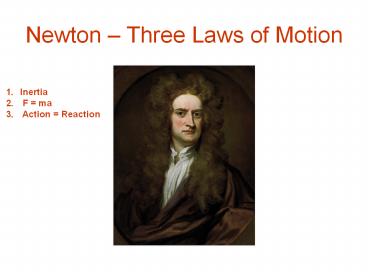Newton - PowerPoint PPT Presentation
1 / 14
Title:
Newton
Description:
Rocket and ignited gases: M(rocket) x V(rocket) = m(gases) x v(gases) ... 1/6 of g(Earth); objects on the Moon fall at a rate six times slower than on the Earth ... – PowerPoint PPT presentation
Number of Views:107
Avg rating:3.0/5.0
Title: Newton
1
Newton Three Laws of Motion
- Inertia
- F ma
- Action Reaction
2
Newtons Laws of Motion
- Law of Inertia A body continues in state of
rest or motion unless acted on by an external
force Mass is a measure of inertia - Law of Acceleration For a given mass m, the
acceleration is proportional to the force applied - F m a
- Law of Action equals Reaction For every action
there is an equal and opposite reaction momemtum
(mass x velocity) is conserved
3
Velocity, Speed, Acceleration
- Velocity implies both speed and direction speed
may be constant but direction could be changing,
and hence accelerating - Acceleration implies change in speed or
direction or both - For example, stone on a string being whirled
around at constant speed direction is constantly
changing therefore requires force
4
Ball Swung around on a String
Same Speed, (in uniform circular motion) Changing
Direction (swinging around the circle)
5
Donut Swung around on a String
6
Conservation of momemtumaction equal reaction
- The momemtum (mv) is conserved before and after
an event - Rocket and ignited gases
- M(rocket) x V(rocket) m(gases) x v(gases)
- Two billiard balls
- m1 v1 m2 v2 m1 v1 m2 v2
- v1,v2 velocities before collision
- v1,v2 velocities after collision
- Example you and your friend (twice as heavy)
on ice!
7
Action Reaction
Equal and Opposite Force from the Table
Net Force is Zero, No Net Motion
8
Acceleration due to gravity
- Acceleration is rate of change of speed or
direction of motion with time - Acceleration due to Earths gravity
- g 9.8 m per second per second, or 32 ft/sec2
- Speed in free-fall
- T (sec) v (m/sec) v
(ft/sec) - 0 0
0 - 1 9.8
32 - 2 19.6
64 - 3 29.4
96 - 60 mi/hr 88 ft/sec (between 2 and 3
seconds)
9
Galileos experiment revisited
- What is your weight and mass ?
- Weight W is the force of gravity acting on a
mass m causing acceleration g - Using F m a, and the Law of Gravitation
- W m g G (m MEarth) /R2
- (R Radius of the Earth)
- The mass m of the falling object cancels out
and does not matter therefore all objects fall
at the same rate or acceleration - g GM / R2
- i.e. constant acceleration due to gravity
9.8 m/sec2
10
Galileos experiment on gravity
- Galileo surmised that time differences between
freely falling objects may be too small for human
eye to discern - Therefore he used inclined planes to slow down
the acceleration due to gravity and monitor the
time more accurately
v
Changing the angle of the incline changes the
velocity v
11
g on the Moon
- g(Moon) G M(Moon) / R(Moon)2
- G 6.67 x 10-11 newton-meter2/kg2
- M(Moon) 7.349 x 1022 Kg
- R(Moon) 1738 Km
- g (Moon) 1.62 m/sec/sec
- About 1/6 of g(Earth) objects on the Moon
fall at a rate six times slower than on the Earth
12
Escape Velocity and Energy
- To escape earths gravity an object must have
(kinetic) energy equal to the gravitational
(potential) energy of the earth - Kinetic energy due to motion
- K.E. ½ m v2
- Potential energy due to position and force
- P.E. G m M(Earth) / R
- (note the similarity with the Law of
Gravitation) - Minimum energy needed for escape K.E. P.E.
- ½ m v2 G m M / R
- Note that the mass m cancels out, and
- v (esc) 11 km/sec 7 mi/sec 25000 mi/hr
- The escape velocity is the same for all
objects of mass m
13
Object in orbit ? Continuous fall !
Object falls towards the earth at the same rate
as the earth curves away from it
14
(No Transcript)































